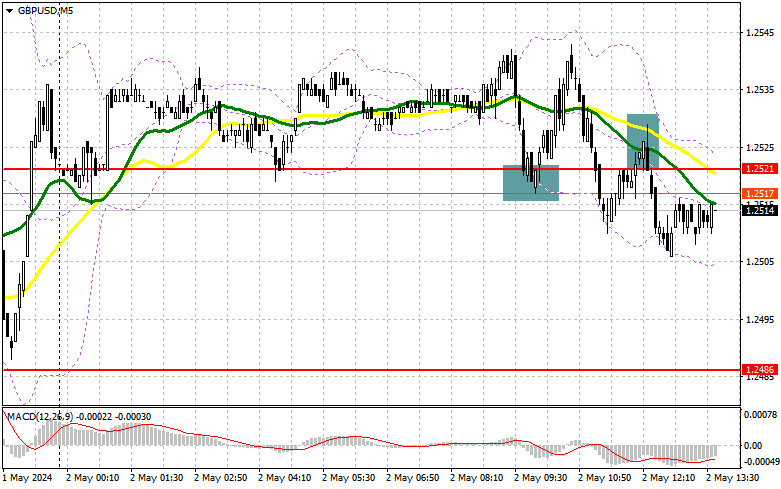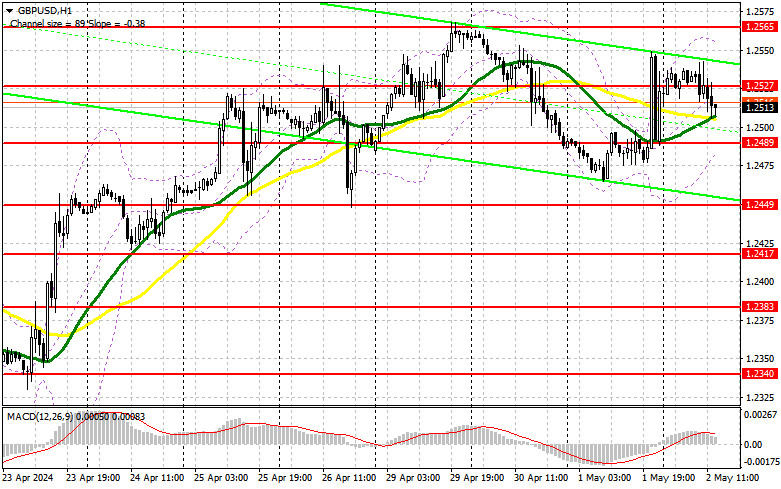
In my morning forecast, I highlighted the level of 1.2521 and planned to base market entry decisions on it. Let's look at the 5-minute chart and analyze what happened there. The decline, along with the formation of a false breakout, enabled a buy signal, leading to the pair rising by more than 20 points. However, after some time, there was a breakout and a reverse test of this range from bottom to top, which allowed for entering short positions. At the time of writing the article, the downward movement was only about 15 points, and that was it. The technical picture was completely revised for the second half of the day.

To open long positions on GBP/USD, the following is required:
The absence of UK statistics did not help buyers maintain control over the market. But ahead of us is a fairly large series of US data, including labor market-related, so the movement promises to be quite good. Figures are expected on initial jobless claims, the balance of trade, changes in labor productivity in the non-manufacturing sector, and changes in labor cost. Poor indicators are a reason to buy the pound, while strong statistics will lead to a further decline in the pair towards the new support at 1.2489, formed at the end of yesterday. A false breakout there will provide an entry point for buying with the aim of returning to the resistance at 1.2527, formed during today's European trading. A breakout and a test of this range from top to bottom against the backdrop of poor statistics are a chance for GBP/USD to rise with a refreshment of 1.2565 - this week's maximum. If there is a breakout above this range, we can talk about a surge to 1.2610, where I plan to take profit. In the scenario of GBP/USD decline and the absence of buyers at 1.2489 in the second half of the day, the market will maintain its balance. In this case, I will look for purchases around 1.2449. A false breakout there will be a suitable option for market entry. I plan to open long positions on GBP/USD immediately on the rebound from 1.2417 with a target of a 30-35 point correction within the day.
To open short positions on GBP/USD, the following is required:
The bears have decent chances to continue pushing the pair down, but to do so, they need to break through 1.2489. In case of GBP/USD rise after weak US labor market data, I will postpone sales until testing the new resistance at 1.2527. Only the formation of a false breakout there will confirm the presence of large sellers in the market, leading to a decline in GBP/USD to around 1.2489. A breakout and a reverse test of this range from bottom to top will increase pressure on the pair, giving bears an advantage and another selling point with the target of updating 1.2449. Testing this level will put buyers in a very dangerous position. The ultimate target will be the minimum at 1.2417, where I will take profit. In the scenario of a GBP/USD rise and the absence of bears at 1.2527 in the second half of the day, bulls will have the opportunity to return to the weekly maximum with an upward movement toward the resistance at 1.2565. I will also only enter sales there on a false breakout. If there is no activity there, I recommend opening short positions on GBP/USD from 1.2610, counting on a downward rebound of the pair by 30-35 points within the day.

Indicator Signals:
Moving Averages
Trading is around the 30 and 50-day moving averages, indicating a bullish sideways market.
Note: The period and prices of moving averages are considered by the author on the hourly chart H1 and differ from the general definition of classic daily moving averages on the daily chart D1.
Bollinger Bands
In case of a decline, the lower boundary of the indicator, around 1.2489, will act as support.
Description of Indicators:
• Moving average (determines the current trend by smoothing volatility and noise). Period 50. Marked in yellow on the chart.
• Moving average (determines the current trend by smoothing volatility and noise). Period 30. Marked in green on the chart.
• MACD indicator (Moving Average Convergence/Divergence). Fast EMA period 12. Slow EMA period 26. SMA period 9.
• Bollinger Bands. Period 20.
• Non-commercial traders - speculators, such as individual traders, hedge funds, and large institutions, using the futures market for speculative purposes and meeting certain requirements.
• Long non-commercial positions represent the total long open position of non-commercial traders.
• Short non-commercial positions represent the total short open position of non-commercial traders.
• The total non-commercial net position is the difference between the short and long positions of non-commercial traders.